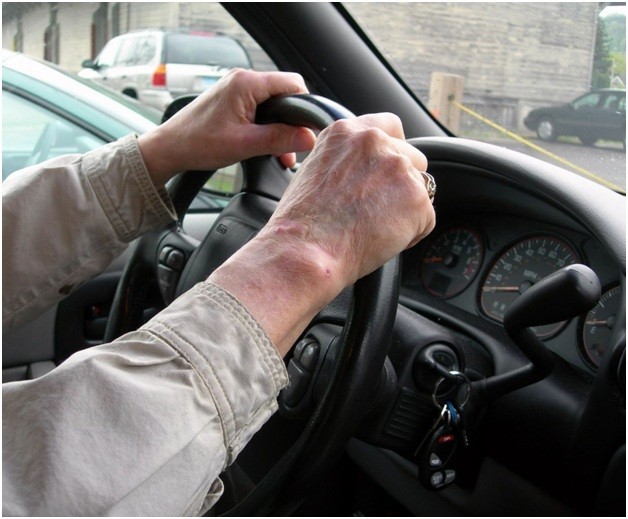It could just be a short trip to the store now and then, or perhaps a drive to the doctor’s and church, on Sundays. Elderly drivers may still be getting behind the wheel to drive themselves to all these places, without acknowledging the risks they expose themselves and the other traffic participants to. “It’s only three miles,” “I’ll be careful,” and other such arguments may be presented by elders who refuse to give up the car keys and admit they are no longer fit to be on the road unassisted.
But in reality, one in three accidents on the road happen within one-mile radius from home, and almost 70 percent take place within a ten-mile radius of home. Drivers, especially older ones, have a tendency to drive without precaution when they’re getting close to home, most probably because familiar surroundings may provide them with a false sense of security. Ironically, the places where people feel safest are, in fact, the ones with the greatest risk of injury and crash.
Compared to the 1970s, when not even half of Americans ages 65 and older had a driver’s license, in 2010, 84% of them were driving. Based on data compiled by the Federal Highway Administration, there were nearly 23.1 million licensed drivers ages 70 or older in 2012, almost 80% of the entire 70+ age group and 11 percent of drivers of all ages. Today, one in six drivers on American roads is 65 years of age or older, driving more miles than they used to a few years ago. According to a survey conducted by the Insurance Institute for Highway Safety, from 1996 to 2008, the average mileage per year for drivers ages 70 and older increased by 42 percent, compared to only 21% increase for drivers ages 33-54.
The fact is, older drivers are staying on the road far more than they used to. On one hand, this may be accounted for by the fact that a lot of American men and women stay in the workforce long after their 65th birthday, resulting in more than double the number of commutes for this age group compared to two decades ago. On the other hand, the increased life expectancy and the higher quality of medical care are making it possible for people ages 70 or older to experience no major impairments that could affect their driving.
However, the fact remains: By 2025, older drivers will account for 25 percent of the entire driving population, compared with 15% in 2001. They may take more precautions and adhere to stricter state policies, but the aging process will still make them more exposed to injury and death on the road, compared to younger drivers.
How Serious Is the Problem?
Although they account for 9 percent of the U.S. population, senior drivers ages 65 or older account for 14 percent of all traffic fatalities and 17 percent of all pedestrian fatalities. According to data from NHTSA’s Traffic Safety Facts reports, in 2010, 3,398 senior drivers ages 65 and older were killed in car accidents, while 4,535 lost their lives as occupants in traffic crashes. Two years later, the NHTSA reported that more than 5,500 people ages 65 or older died and 214,000 were injured in car crashes, a significant increase from previous years. NTHSA mentions that these numbers do not include the increased risk of death and severe injury from low-severity car crashes.
Risk of Injury
In a fatal crash involving a younger driver and a senior driver, the car driven by the older driver was almost two times more likely to be the one that was struck (nearly 60 percent, compared to 35 percent). In almost 50% of two-vehicle fatal crashes, both vehicles were driving straight at the time of collision, and in 22 percent of cases, the older driver was turning left (four times more than the younger driver). At all ages, males have a higher death rate per 100,000 people, compared with females, but the rate triples by age 85 and older.
An NHTSA NASS-CDS study revealed what we already knew: that older drivers are more exposed to injury and death. In order to document the risk of sustaining injury to various parts of the body, researchers examined the crashes of more than 18,000 occupants. The key takeaways:
• Drivers ages 75 or older were the most likely to suffer serious injuries in all body regions, including the head, chest, spine, abdomen, arms, and legs, compared to all other age groups.
• Drivers ages 65-74 and 45-64 had similar risk of suffering injury in the chest, spine, and extremities.
• Drivers least likely to suffer from head or chest trauma belonged to the 25-44 age group.
• Teenage drivers (15-24) had significant risk of sustaining serious injury in the chest area and legs and feet.
A study by RAND Corporation revealed that, in the event of an accident, a passenger in an older driver’s car was 573 percent likelier to be killed, compared with a passenger in an adult driver’s car. On the other hand, a fatality in a younger driver’s car was 44 percent likelier than a fatality in an adult driver’s vehicle. In crashes without other passengers, older drivers had the highest chance of getting killed.
Most Common Crash Types
According to the NHTSA report, older drivers are overrepresented in a variety of crashes, except for those involving alcohol consumption, speeding, and nighttime driving. Since most senior drivers avoid driving at night, 77 percent of all crashes involving drivers ages 65 and older occur during daytime.
For drivers ages 60-69, the crash rate was similar to that of middle-aged drivers, and they were more likely to be involved in accidents at intersections and angle crashes. In single-vehicle accidents, older drivers (in most cases driving alone) were more likely to crash into a parked car and less likely to be able to maneuver the vehicle in order to avoid a potential collision. Drivers over 70 belonged to the age group most likely to be involved in accidents at intersections or on driveways and alleys.
The rate of multiple-vehicle crashes at intersections increased starting at age 60, and they also accounted for 35 percent of fatal crashes among drivers ages 80 or older, compared to 18 percent for the other age groups combined. For drivers ages 80 and older, there wasn’t necessarily an increase in the number of risk factors, but in the extent to which they were exposed to injury and death when involved in accidents. They had the most trouble managing complex situations such as intersections, left turns, and avoiding a potential collision.
Most Common Errors behind the Wheel
Driving is, in itself, a complicated task, requiring drivers’ undivided attention and ability to see and promptly react to everything around them, including other cars, pedestrians, and traffic signs. A car is, oftentimes, a lethal weapon, so the driver must have the right skills, attitude, and knowledge to anticipate potential dangers and be capable of making quick decisions. Drivers should also use their full field of vision to take everything in, especially objects in your blind spots, and be prepared at all times to overcome lack of visibility and other problems on the road. Lastly, drivers should act with courtesy and give other traffic participants the space they need, never provoking or responding to provocations.
Typically, older drivers overestimate their ability to drive. As they age, they are more likely to lose their ability to:
• Maintain concentration on a specific task for a longer period
• Accurately estimate the distance and speed of other vehicles on the road
• Correctly remember directions while driving
• Promptly responding to stopping vehicles and traffic signs
• Pay attention to traffic signs and signals
• Rapidly adjust to changing traffic conditions
• Recognize and avoid distractions
• Coordinate body movements with exterior factors
• Adjust to weather and environmental conditions
In one study of older drivers conducted by scientists at the University of Massachusetts Amherst, it was revealed that some of the mistakes older drivers make behind the wheel are not so much caused by physical deficits, but by learned habits.
One particular driving error was found to be very common among drivers 70 or older: right-of-way crashes, which occurred when one of the drivers failed to yield properly to other cars in an intersection. They expected to find drivers unable to scan the road, to focus on other traffic, or to avoid distractions, but the crashes they were involved in were caused by no such factors. The research revealed that older drivers were not mindful not because they lacked the physical and emotional skills, but because they spent significantly more time looking straight ahead, instead of scanning left and right, as they should have been.
How Does Age Affect Driving
Drivers ages 70 or older may still consider themselves fit to drive – and chances are they will remain that way for a few years more – but there’s no denying that their bodies are going through significant changes, some of which can ultimately impair their capabilities on the road. Here’s how ageing affects the driving experience of the elderly:
Your body: For most of us, aging results in a reduction in flexibility, coordination, and strength. The pain and stiffness in your joints, for instance, may impair your ability to look over your shoulder and change lanes or check out for other traffic at intersections. Due to weakening muscles and leg pain, it can be hard to switch the foot from the gas to the brake pedal, while diminished arm strength may not allow you to turn the steering wheel quickly and effectively.
Your eyesight: A decline in vision may make older drivers more exposed to accidents in complex situations where good visual perception is needed. At night, you may have troubles distinguishing traffic signs and other vehicles, while during the day, glare (from the sun or other cars’ headlights) may obstruct your vision. Vision can be further impaired by eye diseases such as cataract, glaucoma, and macular degeneration.
Your hearing: The ability to hear things may also diminish with age, making it difficult for an older driver to hear sirens, or horns, or noises coming from the car they’re driving.
Your overall health: Specific health disorders may limit or impair older drivers’ ability to drive safely. For instance, Parkinson’s disease, arthritis, or cardiovascular disease can interfere with your driving capabilities. People suffering from brain damage, as caused by dementia or Alzheimer’s, may forget directions or may have a hard time remembering familiar places. In the most severe cases, drivers are unable to tell if they are experiencing any problems behind the wheel, so it’s their family’s responsibility to assess his/her skills regularly.
Hip or knee replacements performed on thousands of aging Americans every year may affect movement behind the wheel. Also, medications can impair driving skills if they have side effects such as drowsiness, sleepiness, lightheadedness, or nausea.
Your reactions: Driving safely involves not only paying attention to your behavior on the road, but to that of other drivers, as well. Reaction times slow with age, and you may be slower in measuring distances, spotting emerging vehicles, or stopping the car promptly to avoid collisions.
Tips for a Safe Driving Experience
Aging doesn’t automatically involve loss of driving ability, but being examined by a physician regularly will keep you in your best possible driving shape. Also, it’s crucial to acknowledge that, while most traffic rules are the same as those you learned three decades ago, traffic is constantly evolving. Vehicle designs, as well as road designs, are constantly subject to change, and you may also notice a higher number of traffic signs regarding pedestrians and bicyclists, as this segment of the population increases.
Here are some tips to make sure that you stay safe behind the wheel at all times:
• Have regular check-ups – check your eyesight and your hearing at least once a year and make sure to wear corrective devices while driving.
• Sleep well at night – sleep deprivation can cause fatigue, drowsiness, clumsiness, and daytime sleepiness, none of which you can afford to experience while you’re driving.
• Drive defensively – Pay extra attention to other drivers and the distractions they may be subject to, leave sufficient braking distance, and make sure your driving matches that of the rest of the traffic.
• Know and respect your limitations – As you age, you may no longer be comfortable driving at night or on long distances. Understand the changes you’re going through and make the necessary adjustments in your driving practices.
• Stay active – Physical exercise will maintain your strength and flexibility, making it easier to turn the wheel or look behind you before changing lanes. Keeping your mind sharp and active, as well, will increase your memory and improve your reactions behind the wheel.
• Manage your health conditions – Some health problems, such as seizures, arthritis, or diabetes, may impair your ability to drive safely. Talk to your physician for managing your condition. Also, pay attention to the medication you’re taking, making sure there are no side effects that could decrease your driving capabilities.
No matter their age, drivers are responsible for how they perform on the road. In ensuring your aging parent is still fit to get behind the wheel, a physician must assess his/her readiness to drive (eye examination, neck mobility, muscle and joint strength, as well as level of drowsiness) and cognitive abilities (memory, reaction time, ability to track moving objects, etc.). At the same time, the older driver must understand that his changing body also requires a change in his driving practices, and start avoiding nights, restricting driving to his/her local area, and avoiding driving under specific weather conditions.
About the Author:
Andrew Winston is a partner at the personal injury law firm of The Law Office of Andrew Winston. He has been recognized for excellence in the representation of injured clients by admission to the Million Dollar Advocates Forum, is AV Rated by the Martindale-Hubbell Law Directory, and was recently voted by his peers as a Florida “SuperLawyer”-an honor reserved for the top 5% of lawyers in the state-and to Florida Trend’s “Legal Elite.”
 Las Vegas Is More Dangerous for Pedestrians than Manhattan
Las Vegas Is More Dangerous for Pedestrians than Manhattan 






















